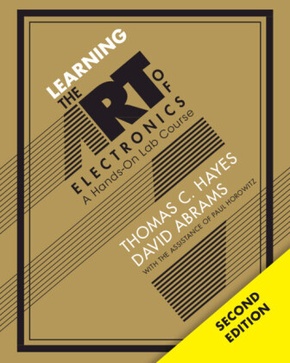Learning the Art of Electronics - A Hands-On Lab Course
| Verlag | Cambridge University Press |
| Auflage | 2025 |
| Seiten | 1180 |
| Format | 20,4 x 4,5 x 25,2 cm |
| Gewicht | 2360 g |
| Artikeltyp | Englisches Buch |
| EAN | 9781009535182 |
| Bestell-Nr | 00953518UA |
Perfect for anyone seeking a hands-on way to learn about the innards of analog and digital circuits in just 28 labs.
The much-anticipated new edition of 'Learning the Art of Electronics' is here! It defines a hands-on course, inviting the reader to try out the many circuits that it describes. Several new labs (on amplifiers and automatic gain control) have been added to the analog part of the book, which also sees an expanded treatment of meters. Many labs now have online supplements. The digital sections have been rebuilt. An FPGA replaces the less-capable programmable logic devices, and a powerful ARM microcontroller replaces the 8051 previously used. The new microcontroller allows for more complex programming (in C) and more sophisticated applications, including a lunar lander, a voice recorder, and a lullaby jukebox. A new section explores using an Integrated Development Environment to compile, download, and debug programs. Substantial new lab exercises, and their associated teaching material, have been added, including a project reflecting this edition's greater emphasis on programmable log ic. Online resources including online chapters, teaching materials and video demonstrations can be found at: http://www.LearningTheArtOfElectronics.com
Inhaltsverzeichnis:
Preface to the second edition; Preface to the first edition; Overview, as the course begins; Part I. Analog: Passive Devices: 1. DC circuits; 2. RC circuits; 3. Diode circuits; Part II. Analog: Discrete Transistors: 4. Transistors I; 5. Transistors II; Part III. Analog: Operational Amplifiers and their Applications: 6. Op-Amps I; 7. Op-Amps II: Departures from ideal; 8. Op-Amps III: Nice positive feedback; 9. Op-Amps IV: Parasitic oscillations; active filter; 10, Op-Amps V: PID motor control loop and lock-in amplifier; 11. Voltage regulators; 12. MOSFET switches and an introduction to JFETs; 13. Group audio project; Part IV. Digital: Gates, Flip-Flops, Counters, PLD, Memory: 14. Logic gates; 15. Introduction to programmable logic; 16. Flip-Flops; 17. Counters; 18. Memory; 19. Finite state machines; Part V. Digital: Analog-digital, PLL, Digital project lab: 20. Analog digital; PLL; 21. Digital project lab; Part VI. Microcontrollers: 22. Microcontrollers I: Introduction; 23. Micro controllers II: Stacks, timers and input; 24. Microcontrollers III: Using internal peripherals; 25. Microcontrollers IV: Timers & interrupts; 26. Microcontrollers V: Serial communication; 27. Microcontrollers VI: Using an RTOS; 28. Project possibilities: toys in the attic; A. Debugging circuits; B. Pinouts; C. Transmission lines; D. Scope advice; O. Online appendices; Index.

